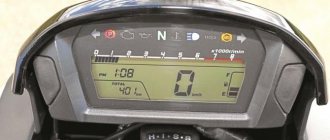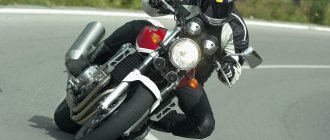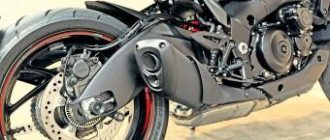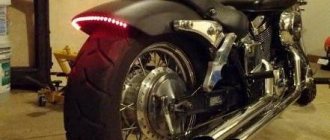| Honda CRF250R (2004-2008) | Honda CRF250R (2009-2012) | Honda CRF250R (2014-2016) |
| Honda CRF250R (2017) | Honda CRF250R (2018-2021) | Honda CRF250R (2022+) |
| Honda CRF250X (2004-2017) | Honda CRF250RX (2018-2021) | Honda CRF250RX (2022+) |
Honda CRF250 Off-Road Motorcycle Series
appeared in September 2003 (2004 model year), introducing two models to the market -
Honda CRF250R
(cross) and
Honda CRF250X
(enduro). These models positioned themselves as a replacement for the obsolete XR line, as well as the 2-stroke motocross model Honda CR250R.
The Honda CRF250R and Honda CRF250X were targeted at the European, North American, Australian and Japanese markets (the CRF250X was available there from late 2010).
The Honda CRF250 series was based on a 1-cylinder, 4-stroke, liquid-cooled engine with a volume of about 250 cm³, with one camshaft and 4 valves. The engine modification for the cross-country version of the Honda CRF250R featured more boost, an exhaust system and constant changes every few years. The engine for the Honda CRF250X was virtually unchanged from 2004 to 2022.
Both models were equipped with an aluminum frame, adjustable sports suspension (inverted fork with a diameter of 47 mm + swingarm with a progressive Pro-Link system and fully adjustable shock absorber), disc brakes and a 5-speed gearbox.
The Honda CRF250R model underwent the first serious restyling in 2009. The motorcycle received a new version of the engine with an increased compression ratio and an injection power system. The engine has also been strengthened through the use of stiffer valve springs and stronger aluminum piston material. The frame has become thinner and lighter, the wheelbase and swingarm length have been increased, and the diameter of the fork stays has been increased to 48 mm.
In 2010, as mentioned above, the Honda CRF250X model became officially available on the Japanese market. Unlike the cross version, the CRF250X did not undergo major changes and was still equipped with a carburetor power system.
In 2012, a new budget model Honda CRF250L appears, which, although it has a similar name, does not belong to the full CRF line.
By August 2013, Honda introduced an updated version of the cross-country model Honda CRF250R. The motorcycle received a new generation of frame and pendulum. To improve weight distribution, the exhaust has become double. The suspensions remained the same, but changed their characteristics to suit the new frame and pendulum. New generation of engine - increased compression ratio, modified piston and combustion chamber design, new 2-stage fuel injection system 2 PGM-FI.
In 2022, the Honda CRF250R model receives another major update. New engine - increased the compression ratio, received a new cylinder head with two camshafts (DOHC), new titanium valves, a new intake design, an electric starter instead of a kick. New frame. Electronic systems: 3-stage launch control (HRC Launch Control), engine mode selection (Engine Mode Select Button - EMSB). The new front suspension is an inverted fork with a 49 mm diameter of stays.
For 2022, the Honda CRF250R gets a slight makeover with new camshafts and updated styling. By 2022, the Honda CRF250X model will change its name to Honda CRF250RX
, gets a new look, a new engine from the CRF250R, featuring ignition tuning, suspension tuning and increased fuel tank capacity.
In the summer of 2022, Honda introduced the new 2022 CRF250R and CRF250RX. The updated models received a new generation of frame, new engine settings (more torque at mid-range), 9-disc clutch, single exhaust. The RX modification received hand protection as standard.
The main competitors of the Honda CRF250R (cross) in the class:
- Kawasaki KX250F
- Suzuki RM-Z250
- Yamaha YZ250F
The main competitors of the Honda CRF250X (enduro) in the class:
- Yamaha WR250
- Kawasaki KLX250/KX250X
Brief history of the model
- September 2003 (2004 model year) - start of production and sales.
Model
: Honda CRF250R;
Honda CRF250X (Europe, North America, Australia, Japan). Factory designation:
CRF250R4; CRF250X4.
- 2005 - no significant changes.
Model
: Honda CRF250R;
Honda CRF250X (Europe, North America, Australia, Japan). Factory designation:
CRF250R5; CRF250X5.
- 2006 - no significant changes.
Model
: Honda CRF250R;
Honda CRF250X (Europe, North America, Australia, Japan). Factory designation:
CRF250R6; CRF250X6.
- 2007 - no significant changes.
Model
: Honda CRF250R;
Honda CRF250X (Europe, North America, Australia, Japan). Factory designation:
CRF250R7; CRF250X7.
- 2008 - no significant changes.
Model
: Honda CRF250R;
Honda CRF250X (Europe, North America, Australia, Japan). Factory designation:
CRF250R8; CRF250X8.
- 2009 - restyling of the Honda CRF250R model.
Model
: Honda CRF250R;
Honda CRF250X (Europe, North America, Australia, Japan). Factory designation:
CRF250R9; CRF250X9.
- October 2010 - the Honda CRF250X model receives LED optics and begins to be sold in Japan. Since this CRF250X model comes as a 2011 version, this modification was not officially produced in 2010.
Model
: Honda CRF250R (Europe, North America, Australia, Japan).
Factory designation:
CRF250RA.
- 2011 - no significant changes.
Model
: Honda CRF250R;
Honda CRF250X (Europe, North America, Australia, Japan). Factory designation:
CRF250RB; CRF250XB.
- 2012 - no significant changes.
Model
: Honda CRF250R;
Honda CRF250X (Europe, North America, Australia, Japan). Factory designation:
CRF250RC; CRF250XC.
- 2013 - restyling of the Honda CRF250R model.
Model
: Honda CRF250R;
Honda CRF250X (Europe, North America, Australia, Japan). Factory designation:
CRF250RD; CRF250XD.
- 2014 - The CRF250X was not modified this year.
Model
: Honda CRF250R (Europe, North America, Australia, Japan).
Factory designation:
CRF250RE.
- 2015 - no significant changes.
Model
: Honda CRF250R;
Honda CRF250X (Europe, North America, Australia, Japan). Factory designation:
CRF250RF; CRF250XF.
- 2016 - no significant changes.
Model
: Honda CRF250R;
Honda CRF250X (Europe, North America, Australia, Japan). Factory designation:
CRF250RG; CRF250XG.
- 2017 - restyling of the Honda CRF250R model.
Model
: Honda CRF250R;
Honda CRF250X (Europe, North America, Australia, Japan). Factory designation:
CRF250RH; CRF250XH.
- 2018 - Honda CRF250X is no longer produced. Restyling of the Honda CRF250R model.
Model
: Honda CRF250R (Europe, North America, Australia, Japan).
Factory designation:
CRF250RJ.
- 2019 - restyling of the Honda CRF250X, which now has a different name - Honda CRF250RX.
Model
: Honda CRF250R;
Honda CRF250RX (Europe, North America, Australia, Japan). Factory designation:
CRF250RK; CRF250RXK.
- 2020 - no significant changes.
Model
: Honda CRF250R;
Honda CRF250RX (Europe, North America, Australia, Japan). Factory designation:
CRF250RL; CRF250RXL.
- 2021 - no significant changes.
Model
: Honda CRF250R;
Honda CRF250RX (Europe, North America, Australia, Japan). Factory designation:
CRF250RM; CRF250RXM.
- 2022 - restyling of the model. New generation of frame (less weight, better cornering), new engine settings to improve mid-range performance (new camshaft sprocket, new timings for opening/closing valves and ignition), new clutch (9 discs, smoother torque transmission, lighter squeeze), a new exhaust system (two mufflers were replaced by one), a new front fork (travel increased by 5 mm), the RX version received stock hand protection.
Model
: Honda CRF250R;
Honda CRF250RX (Europe, North America, Australia, Japan). Factory designation:
CRF250RN; CRF250RXN.
Driving performance
Acceleration to 100 km is 5 seconds. The measurements were carried out under factory conditions.
According to users, 95 is reached even faster, but the bike simply does not want to accelerate further.
Maximum speed
The maximum speed declared by the developers is 100 km/h . According to users, with the correct settings, the cross version can reach 150 km/h. True, the headwind interferes greatly.
Fuel consumption
Fuel consumption depends on road conditions, but with the right settings it does not rise above 4.5 liters. per 100 km .
Reviews
Reviews about Honda CRF 250:
Expand Collapse
Traditionally for the “red and white”, the CRF250X is equipped with an inverted two-chamber Showa cartridge fork with a 47 mm diameter of stays. I would like to make a reservation right away: if a motorcycle is destined for a sporting destiny, it cannot be done without the intervention of a specialist. The stock suspension is too soft. Of course, its energy intensity is quite enough for amateur country trips, but on a serious track the Showa starts to get tired quite quickly. But the potential of the braking mechanisms is enough, as they say, with a reserve.
The motorcycle has excellent weight distribution, with 46.8% of its total weight falling on the front axle. That's why the CRF250X has very light and sharp handling. Despite the loose and soft suspension settings, the motorcycle handles almost at the same level as its sportier cross-country cousin.
But when purchasing a CRF250X, you need to clearly understand that in order to participate in serious competitions, this “semi-finished product” will have to be seriously modified. First of all, you need to seriously invigorate the engine. Work some magic with the carburetor and modify the airbox of the motorcycle, as well as replace the stock parts with the appropriate tuning ones. The crankshaft, piston, cylinder, ignition unit, camshafts and exhaust system all need to be replaced. All this wealth, of course, will need to be properly tuned on the dyno. In order to match the increased power and torque, you will definitely have to do suspension tuning. You will have to change the springs in the fork and shock absorber. And properly reconfigure the hydraulic suspension system.
Honda CRF250X. The aesthetics of this motorcycle are distinguished by its dual exhaust system. It is created, like Kawasaki, on the basis of motocross models adapted to the enduro class.
The single-shaft timing engine (Unicam system) is very compact, but lacks an electric starter. Quite playful, it demonstrates an impeccable increase in power, both on the artificial track and on the mountain, thanks to the absence of surges at high revs, which guarantees good traction on any surface. This, to some extent, is also its drawback, since on the one hand, the increase in torque is very effective, but on the other hand, it is not very exciting. Like all Hondas, off-road and beyond, it boasts a “natural” front end that allows you to be bold on a man-made track, and on a mountain road to enjoy the ride without worrying too much about the behavior of the front wheel. Its drawback is the reaction of the fork to a series of obstacles: here it responds rather dryly, transmitting shocks to the steering wheel. This is due to the settings, which, although quite smooth, are a little harsh at the first stage, and therefore cannot absorb all irregularities with sufficient accuracy.
Braking is good, but the saddle position could be better, as the handlebars are a little low for standing riding and the footpegs are a bit high. In terms of its performance, Honda is literally ahead of the Husky by a hair.
Specifications
Despite the fact that the engine capacity of both versions is the same, the power is different. At the same time, the difference in the issued “horses” varies by almost one and a half times.
You can be confident in the reliability of Honda engines, especially if it is a motor for a motocross motorcycle.
For a motocross motorcycle, different, forced settings are used, but the engine remains alone. This is a 1-cylinder 4-stroke engine (the first value is for cross-country, the second for enduro);
- working volume - 248 cm3;
- power - 43.30 hp;
- number of valves - 4;
- diameter - 30, 31;
- cylinders - 1;
- cooling - liquid;
- fuel supply - injector (since 2010), carburetor;
In recent years, the engine has undergone several changes - torque at low speeds has been increased, and a mode change button has appeared on the R model.
- ignition - transistor, electronic;
- start - kick starter, electric starter;
- fuel tank - 6.5 and 7.3 l.
Starting the engine did not have strict regulations. Enduro could only have a foot, while racing could only have a button and vice versa. There were versions with two working options.
Transmission and clutch
The bikes have a 5-speed gearbox. There are no special settings depending on the model.
But users note that if the bike is destined for a sporting destiny, it is better to immediately replace the gearbox with a tuned one that shifts more clearly and has less free play. In contrast, owners of enduro versions notice that the factory gearbox works quite normally, the gear ratios are selected within reasonable limits, and there is no need to apply any new solutions to it - “ it works and don’t touch it .”
The clutch cover bears the Honda inscription.
- The clutch in both versions follows the same principle - multi-disc , using an oil bath.
- Drive - chain .
Chain catcher.
Tension roller.
Chain lock.
Brakes
Both models have 1-disc hydraulic brakes. The difference is insignificant - only in the diameter of the front disc.
Therefore, only the settings of the enduro model will be given below. The cross's front disc is 20 mm wider .
The front brake disc is covered with a plastic lining, carefully made and neatly fitted.
Front brakes:
- number of disks - 1;
- diameter - 240 mm;
- support - 2-piston.
Rear brakes:
- number of disks - 1;
- diameter - 240 mm;
- support - 1-piston.
No options provided.
Dimensions and weight
The curb weight of the enduro bike was 115 kg. Version R (cross) is 10 kg less.
The Honda turned out to be quite light compared to its competitors.
The overall dimensions are also slightly different (the first parameter is enduro, the second is cross):
- in length - 2181, 2174 mm;
- width - 827, 827 mm;.
- Height - 1271, 1261 mm, square saddle - 961, 958 mm.
- Ground clearance - 322, 340 mm.
SFF fork on a Honda motorcycle
The SFF fork on a Honda motorcycle distributes the shock absorber functions between two struts. On the left is a three-chamber air spring system that regulates pressure, while on the right are damping mechanisms to control recoil. The pressure in the compensation and internal chambers can be adjusted. The 174 psi pressure in the inner chamber corresponds to the maximum spring rate, which is adjustable over a range of 20 psi. High pressure provides good controllability as speed increases. A compensation chamber located at the bottom of the fork regulates sag and initial travel of the fork. The higher the pressure in this chamber, the lower the fork goes. The outer chamber is unadjustable, but for better handling, you can optionally install a Schrader valve on the fork, although Showa representatives warn that the system may burn out. The right rack houses a 16-position adjuster for recoil and compression damping. One of the main advantages of an air fork is its weight; the front end of the new Honda CRF250R is 2.8 pounds lighter.
After some minor adjustments to the pressure and rebound levels, the new fork performed well on the track. Overall, we think the SFF-Air forks on Honda's bikes are the best yet, although we did note some pressure build-up towards the end of the 20-minute test in the heat. We have only scratched the surface of the design of the model, but the air fork has already amazed us. But here’s some advice: get a notebook and write down all the settings in detail. Because with so many different regulators, it doesn’t take long to get confused.
SFF fork on a Honda motorcycle
Honda CRF250R doesn't see many changes for 2015
Considering that the 2014 model has already been heavily redesigned, the new Honda CRF250R has not undergone many changes, but they are all significant. Let's immediately note the 49mm TAC SFF-Air fork from Showa. At the beginning, we weren't sure that the air fork was worth praising so much. But one way or another, in the camp of motocross bikes, the future belongs to pneumatics. In the end, we will all learn how to handle them and perhaps laugh, looking back at the time when we did not think of alternatives to springs.
Modifications (CRF250L, CRF250M, CRF250L Rally)
In addition to those described on the Internet, there are references to three more modifications.
- Honda CRF250L - an enduro motorcycle that has common features with the development of the plant CBR250. Deformed engine, complete absence of any settings for the suspension, at least some innovations, steel frame.
It’s better not to go into such jungle on a lightweight version, and Honda itself classifies the L-ku as a dual-purpose bike, and not as an uncompromising “dirt mixer”.
- Honda CRF250M assembled on the basis of the previous one, full compliance with technical characteristics, road tires and wheels of the same diameter classify it as a motard.
Already from its appearance it is noticeable that the M is more oriented towards road use.
- Honda CRF250L Rally is the next stage of development of the L model. Increased height, ground clearance, larger brake discs and stock ABS for European markets.
Apart from the same engine capacity - 248 cm3, there are no other common parts. The first two models were presented by the concern for budget users in 2012.
If we compare in numbers, budget models initially lag behind the R and X versions, which the developers position as the flagships of the line.
Users note that these budget versions have one big advantage - an almost ideal weight distribution of 46/54% , which makes riding such a bike no more difficult than a bicycle ride.
Flaws
- Difficult to maintain.
- It's not easy to catch neutral.
- You need to get used to the sensitive reaction to the movement of the gas/brake handles.
Advantages
- Dynamism and traction.
- Checkpoint.
- Maneuverability.
- Lightweight and manageable.








